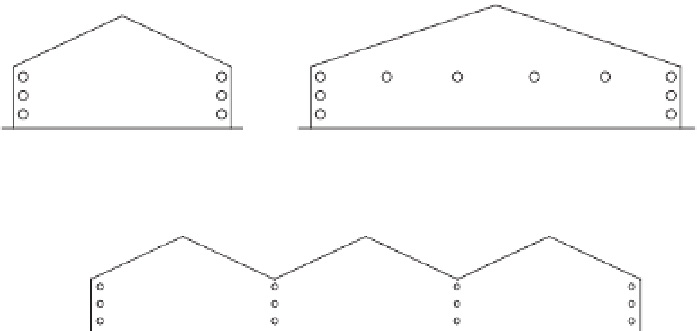Agriculture Reference
In-Depth Information
These systems are also known as heating
facilities by 'thermosyphon' (a method of
passive heat exchange based on natural con-
vection which circulates liquid without the
necessity of a mechanical pump) because
originally the water circulated naturally (pro-
pelled by the hot water being in a high posi-
tion in a circuit and return of cold water in a
low position). Nowadays, all systems are run
by means of pumps which force the circula-
tion. This improves their efficiency and
allows for the use of smaller diameter pipes
than the original natural circulation systems.
In conventional systems, water circulates
at high temperature (50-80°C), at about
0.3-1.0 m above the ground (Fig. 7.7). Their
thermal efficiency is not good, as they lose
50% of the heat by radiation towards the
cover (Urban, 1997a). They must be used in
association with thermal screens that limit
these losses. The most commonly used pipes
are circular in cross-section although there
are other types, and they may suspended by
chains above the crop so that they can be
moved vertically as the crop grows (C in
Fig. 7.8 and Fig. 7.9). They are usually built of
steel but, also, of aluminium, or even plastic.
Nowadays, the use of heating pipes in pairs is
widespread; they are used as rails to transport
trolleys and mechanized elements (Photo 7.4).
To avoid condensation of water over the crop,
sometimes additional pipes may be installed
in the canopy (and managed at low tempera-
ture) (Kamp and Timmermen, 1996).
The use of water vapour as the fluid for
distributing heat (still in use in very cold
climates) has not received wide acceptance
in Europe and is being displaced (in the few
existing facilities) by hot-water heating
systems.
Fig. 7.7.
Traditional location of water heating pipes (high temperature) in greenhouses, in narrow single-
span greenhouses (top left), wide ones (top right) or multi-span (bottom).
I
C
J
A
A
K
H
B
D
G
E
F
Fig. 7.8.
Distribution scheme of the different elements for greenhouse heat distribution. A, Side radiant
pipe; B, radiant pipe over the soil; C, aerial radiant pipe; D, radiant pipe over the soil for table cultivation;
e, radiant pipe under the growing table; F, heating elements integrated in the growing table; G, heating
elements over the growing table; H, Pe hoses over the soil; I, fan coil with vertical discharge; J, aerial Pe
hoses; K, low hot air generator (adapted from Hernández, 2002).



